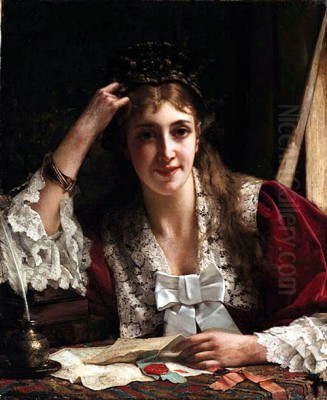
Jan Frederik Pieter Portielje stands as a significant figure in 19th-century European art, a painter whose career bridged the artistic traditions of the Netherlands and Belgium. Born in Amsterdam on April 20, 1829, and passing away in Antwerp on February 6, 1908, Portielje became renowned for his exquisitely detailed genre scenes and portraits, particularly his captivating depictions of elegant women in refined interior settings. His work, characterized by technical precision and a keen eye for capturing mood and personality, found widespread acclaim during his lifetime and continues to be appreciated by collectors and art enthusiasts today.
Early Life and Artistic Formation
Portielje's artistic journey began in his birth city of Amsterdam, a historic center of Dutch art. He received his foundational training at the city's prestigious Royal Academy of Fine Arts (Koninklijke Academie van Beeldende Kunsten). This early education would have immersed him in the strong traditions of Dutch painting, known for its realism, attention to detail, and mastery of light – elements that would remain visible throughout his career, even as his style evolved.
Seeking broader horizons and further development, Portielje later moved to Antwerp, Belgium. This city was a major artistic hub in the 19th century, boasting its own Royal Academy of Fine Arts, which rivaled institutions across Europe. Antwerp's academy, under figures like Nicaise de Keyser and later influenced by the historical painter Hendrik Leys, fostered a high standard of academic training. Portielje enrolled in the Antwerp Royal Academy, further honing his skills in drawing, composition, and oil painting techniques. This Belgian influence added another layer to his artistic identity, blending Dutch precision with the slightly more flamboyant or romantic tendencies often seen in Belgian art of the period.
Travels and Career Development
Portielje's artistic education was not confined to the academies. Like many ambitious artists of his time, he understood the importance of travel for exposure to different styles, patrons, and artistic environments. He undertook significant journeys, spending extended periods in France, particularly Paris, and also traveling in Germany. Paris, the undisputed capital of the 19th-century art world, was a crucial destination. During his stays there, Portielje established himself primarily as a portrait painter.
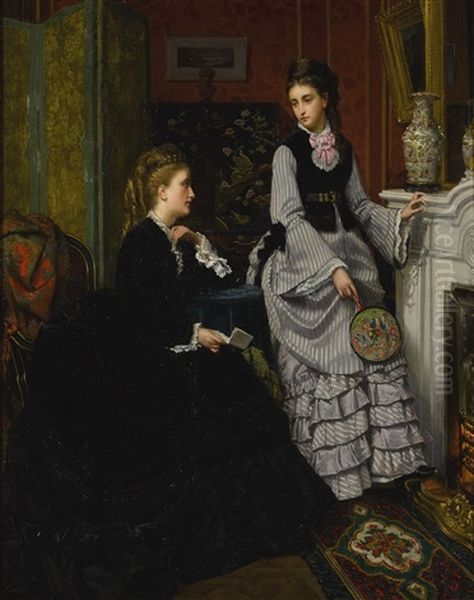
His skill in rendering likenesses, combined with his ability to imbue his subjects with an air of grace and sophistication, made him sought after. It was likely during this period, exposed to the elegance of Parisian society and art, that his preference for depicting fashionable women in luxurious settings solidified. His time in France and Germany broadened his artistic perspective and likely brought him into contact with the works of leading French academic painters such as Jean-Léon Gérôme or Alexandre Cabanel, whose polished techniques and popular subject matter dominated the official Salons.
Eventually, Portielje settled permanently in Antwerp, which became his primary base of operations for the remainder of his long and productive career. While based in Belgium, his reputation transcended national borders. His paintings became highly popular not only in Belgium and the Netherlands but also found eager markets in France, Germany, and notably, the United States. He cultivated relationships with prominent art dealers, ensuring his work reached an international clientele. This commercial success speaks to the wide appeal of his chosen subjects and his meticulous, accessible style, contrasting with the more challenging path of avant-garde contemporaries like his fellow Dutchman Vincent van Gogh.
Artistic Style and Thematic Focus
Jan Portielje's style is best characterized as Academic Realism, deeply rooted in the meticulous techniques favored by the art academies of the 19th century. His work consistently displays a high degree of finish, with smooth brushwork, careful attention to detail, and a commitment to representing textures accurately. Fabrics – silks, satins, velvets, lace – are rendered with palpable realism, contributing significantly to the sense of luxury and refinement in his scenes.
While initially trained in traditions stemming from Romanticism and Academic classicism, some sources suggest a later, perhaps subtle, influence from Impressionism. However, viewing his main body of work, it's clear Portielje remained fundamentally a realist painter. Unlike the Impressionists, such as Claude Monet or Pierre-Auguste Renoir, he did not adopt their loose brushwork or focus on the fleeting effects of light. Instead, his lighting is typically controlled and studio-based, designed to enhance the beauty of his subjects and the richness of their surroundings. Any "Impressionist" influence might be seen more in a general awareness of color vibrancy or perhaps a slightly softer focus in some later works, rather than a fundamental shift in technique.
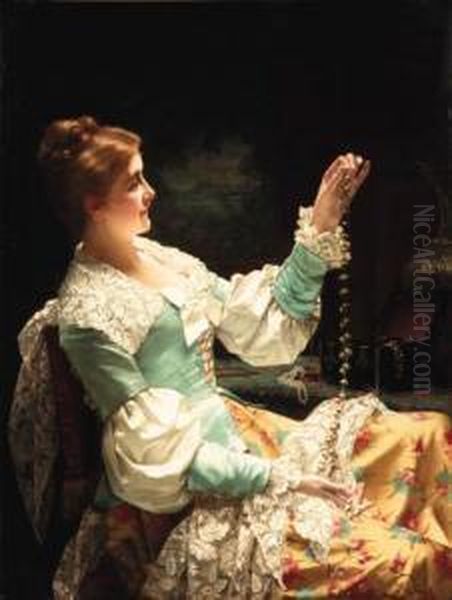
Thematically, Portielje overwhelmingly focused on the depiction of women. His subjects are typically portrayed as paragons of contemporary elegance and beauty, often shown in lavishly decorated interiors. These settings are not mere backdrops but integral parts of the composition, filled with carefully rendered furniture, tapestries, objets d'art, and floral arrangements. The women themselves are often engaged in quiet, domestic activities – reading letters, arranging flowers, admiring jewelry, lost in thought, or engaging in quiet conversation, as seen in works like Whispered Confidences.
A distinct and recurring theme within his oeuvre is a form of gentle Orientalism. Portielje frequently painted women dressed in exotic, often vaguely Middle Eastern or Eastern European-inspired costumes, sometimes referred to as "Gypsy" attire in titles like Gypsy Girl or The Gypsy Girls. Unlike the more ethnographic or dramatic Orientalist works of painters like Jean-Léon Gérôme or Frederick Arthur Bridgman, Portielje's Orientalism seems more focused on the decorative possibilities of the costumes and the allure of the "exotic," often placing these figures within conventional European interior settings. This catered to a popular 19th-century taste for the exotic and picturesque.
His portraits and genre scenes consistently emphasize grace, poise, and an idealized vision of femininity. He excelled at capturing subtle expressions and conveying a sense of inner life, even within highly polished and somewhat staged compositions. His work shares some thematic ground with other successful painters of modern life and elegant society, such as the Belgian Alfred Stevens or the French painter James Tissot, though Portielje often maintained a slightly more intimate, less overtly narrative focus.
Representative Works
Throughout his prolific career, Jan Portielje created numerous paintings that exemplify his style and thematic interests. While a comprehensive list is extensive, several works stand out as representative of his artistic achievement:
Whispered Confidences: This painting is a quintessential Portielje work, depicting two elegantly dressed women sharing a secret in a richly appointed interior. It showcases his skill in rendering fabrics, capturing intimate gestures, and creating a warm, inviting atmosphere through careful use of color and light. The work highlights his ability to suggest a narrative or emotional connection between figures.
The Jewel Box: Often depicting a solitary woman admiring or selecting jewelry, this theme allowed Portielje to combine portraiture with the detailed rendering of luxurious objects. Such works emphasize wealth, beauty, and moments of private contemplation.
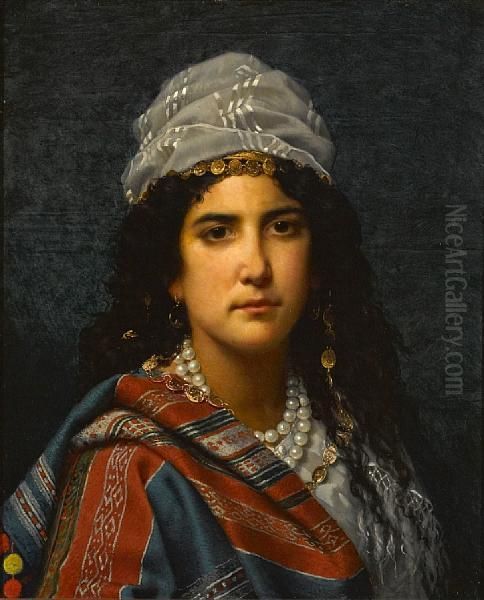
Gypsy Girl / The Gypsy Girls: These titles represent his engagement with Orientalist themes. Typically featuring young women in colorful, non-Western attire, often with a direct gaze towards the viewer, these paintings highlight Portielje's skill in capturing vibrant textiles and suggesting an alluring, slightly mysterious persona.
Young Woman with a Parrot: Incorporating animals, particularly exotic birds like parrots, was another way Portielje added visual interest and a touch of the exotic to his interior scenes. This work likely features a beautifully dressed woman interacting with a colorful parrot, combining portraiture, detailed setting, and an element of the unusual.
The Little Soldier: While less typical than his depictions of women, this title suggests Portielje also engaged with other genre subjects, possibly depicting a child in military costume, a popular sentimental theme in the 19th century.
Other notable titles often associated with Portielje include The Love Letter Tapestry, An Interior Beauty, A Southern Belle, An Eastern European Beauty, Where Art Thou?, Esmeralda, A Maiden of Diamante, Idle Thoughts, An Edwardian Woman, and Girls in Finery. Collectively, these works demonstrate his consistent focus on beauty, elegance, detailed execution, and themes drawn from contemporary life and romanticized exoticism.
Collaborations and Contemporaries
The 19th-century art world often involved collaboration, and Portielje was no exception. Sources indicate that he collaborated with fellow artists, most notably Eugène Rémy Maes (or Maas) and Frans Lebret. Maes was known for his depictions of animals, particularly poultry, and Lebret was also a painter. It is likely that in these collaborations, Portielje might have painted the figures or primary subjects, while his collaborators contributed specific elements like animals, landscape backgrounds, or detailed still-life components, a common practice to leverage individual artists' strengths.
Positioning Portielje among his contemporaries helps to understand his place in art history. In Belgium, his work relates to the broader school of Belgian Realism and genre painting, which included artists like Gustave De Jonghe, who also specialized in elegant interior scenes, and the internationally renowned animal painter Henriette Ronner-Knip. While distinct from the Hague School painters in the Netherlands like Jozef Israëls, who focused on more somber scenes of rural and fishing life, Portielje represents the more cosmopolitan, commercially successful strand of Dutch-Belgian art.
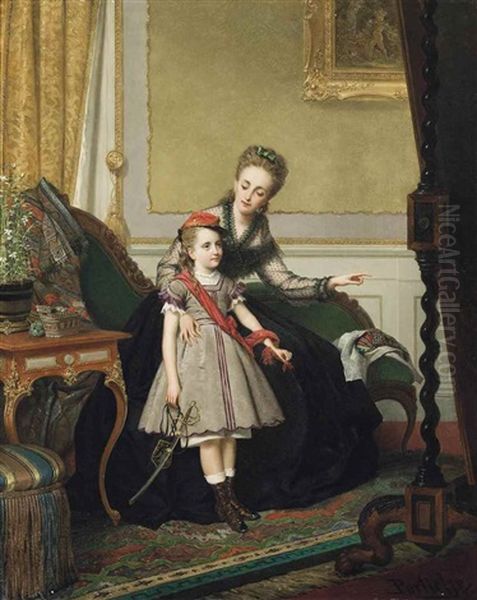
His meticulous technique and detailed realism bear comparison to the Dutch-born, British-based painter Sir Lawrence Alma-Tadema, who achieved immense fame for his scenes of classical antiquity rendered with photographic precision. Although their subject matter differed, both artists shared a commitment to high finish and appealing, easily understandable subjects. Portielje's idealized female figures also resonate with the popular works of French academic masters like William-Adolphe Bouguereau, whose smooth, idealized nudes and portraits were immensely popular with the same bourgeois clientele that appreciated Portielje.
Family and Artistic Legacy
Jan Portielje's artistic inclinations were passed down within his family. His son, Edward Antoon Portielje (1861–1949), also became a painter, following closely in his father's footsteps. Edward specialized in similar subjects, particularly genre scenes featuring fishermen and women in traditional Dutch or Belgian coastal settings, as well as elegant interior scenes that clearly show his father's influence. The Portielje name thus became associated with a particular style of detailed, charming genre painting across two generations.
Jan Frederik Pieter Portielje's legacy rests on his mastery of academic technique and his creation of a body of work that perfectly captured the tastes of his time. He was not an avant-garde innovator pushing the boundaries of art, but rather a highly skilled practitioner who excelled within established conventions. His paintings offered viewers glimpses into idealized worlds of elegance, beauty, and quiet domesticity, sometimes spiced with a touch of exoticism.
His success during his lifetime, marked by international exhibitions (including the Antwerp International Exposition) and widespread patronage, attests to his skill and the appeal of his art. Today, his works are held in various museum collections, including the Alfred Ost Museum in Belgium and the Bendigo Art Gallery in New South Wales, Australia, as well as appearing frequently on the art market. He is remembered as a prominent figure in Belgian and Dutch art of the latter half of the 19th century, a master of depicting feminine grace and the luxurious textures of his era.
Conclusion
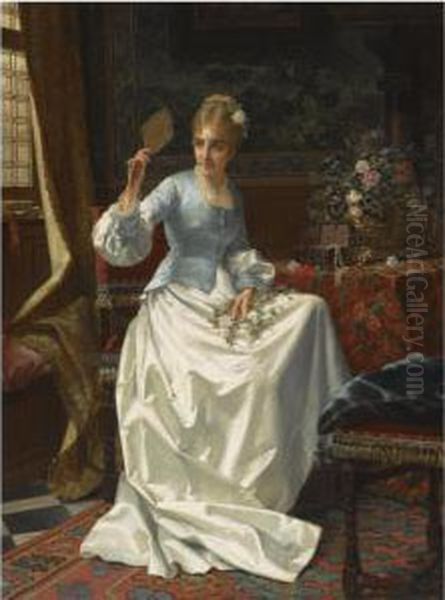
Jan Frederik Pieter Portielje carved a distinct niche for himself in the bustling art world of the 19th century. As a Dutch-born artist who made his career primarily in Belgium, he synthesized influences from both traditions, creating a style characterized by meticulous realism, refined aesthetics, and appealing subject matter. His focus on elegant women, detailed interiors, and occasional forays into gentle Orientalism resonated deeply with contemporary audiences in Europe and America. Through his technical skill, his prolific output, and his successful navigation of the international art market, Portielje achieved significant recognition during his lifetime. While perhaps overshadowed in art historical narratives by the rise of Impressionism and Modernism, his work endures as a testament to the enduring appeal of academic craftsmanship and the idealized depiction of beauty and grace.